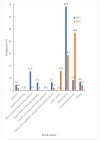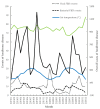Impact of Foodborne Disease in Taiwan during the COVID-19 Pandemic
- PMID: 38541231
- PMCID: PMC10972290
- DOI: 10.3390/medicina60030505
Impact of Foodborne Disease in Taiwan during the COVID-19 Pandemic
Abstract
Background and Objectives: The coronavirus disease 2019 (COVID-19) pandemic originated in Wuhan, China, in December 2019, the first case diagnosed since January 2020 in Taiwan. The study about the potential impact of the COVID-19 pandemic on event, location, food source, and pathogens of foodborne disease (FBD) is limited in Taiwan. Our aim in this study is to investigate FBD in the context of the COVID-19 pandemic. Materials and Methods: We collected publicly available annual summary data from the FBD dataset in the Taiwan Food and Drug Administration and Certifiable Disease on reported FBD in Taiwan from 2019 to 2020. We used logistic regression to evaluate changes in the occurrence or likelihood of FBD cases and Poisson regression to examine the relative risk (RR) between FBD and climate factors. Results: Similar events occurred in 2019 and 2020, but the total number of FBD cases decreased from 6935 in 2019 to 4920 in 2020. The places where FBD decreased were in schools, hospitals, outdoors, vendors, and exteriors. The top place in FBD shifted from schools to restaurants. The top food source for FBD has changed from boxed food to compound food. Bacillus cereus and Salmonella emerged as the top two observed bacterial pathogens causing FBD. The risk of FBD cases increased with a higher air temperature, with an RR of 1.055 (1.05-1.061, p < 0.001) every 1 °C. Conclusion: The incidence of FBD decreased significantly during the COVID-19 pandemic in Taiwan. This decline may be attributed to protective measures implemented to control the spread of the virus. This shift in locations could be influenced by changes in public behavior, regulations, or other external factors. The study emphasizes the importance of understanding the sources and effectiveness of severe infection prevention policies. The government can use these findings to formulate evidence-based policies aimed at reducing FBD cases and promoting public health. Consumers can reduce the risk of FBD by following safe food handling and preparation recommendations.
Keywords: COVID-19 pandemic; foodborne diseases; surveillance.
Conflict of interest statement
The authors declare no conflicts of interest.
Figures






Similar articles
-
Surveillance of foodborne diseases in Taiwan: A retrospective study.Medicine (Baltimore). 2021 Feb 5;100(5):e24424. doi: 10.1097/MD.0000000000024424. Medicine (Baltimore). 2021. PMID: 33592891 Free PMC article.
-
Decreased Incidence of Infections Caused by Pathogens Transmitted Commonly Through Food During the COVID-19 Pandemic - Foodborne Diseases Active Surveillance Network, 10 U.S. Sites, 2017-2020.MMWR Morb Mortal Wkly Rep. 2021 Sep 24;70(38):1332-1336. doi: 10.15585/mmwr.mm7038a4. MMWR Morb Mortal Wkly Rep. 2021. PMID: 34555002 Free PMC article.
-
Foodborne Diseases: A Study before and during the COVID-19 Pandemic in Brazil.Nutrients. 2023 Dec 25;16(1):60. doi: 10.3390/nu16010060. Nutrients. 2023. PMID: 38201890 Free PMC article.
-
A review on foodborne disease outbreaks in Bhutan.WHO South East Asia J Public Health. 2021 Jul-Dec;10(2):101-104. doi: 10.4103/WHO-SEAJPH.WHO-SEAJPH_117_21. WHO South East Asia J Public Health. 2021. PMID: 35532603 Review.
-
Expediting pathogen genomics adoption for enhanced foodborne disease surveillance in Africa.EBioMedicine. 2025 Jan;111:105500. doi: 10.1016/j.ebiom.2024.105500. Epub 2024 Dec 18. EBioMedicine. 2025. PMID: 39700896 Free PMC article. Review.
Cited by
-
Impact on Human Health, Lifestyle, and Quality of Care After COVID-19.Medicina (Kaunas). 2025 Mar 29;61(4):630. doi: 10.3390/medicina61040630. Medicina (Kaunas). 2025. PMID: 40282921 Free PMC article.
References
-
- Hui D.S., IAzhar E., Madani T.A., Ntoumi F., Kock R., Dar O., Ippolito G., Mchugh T.D., Memish Z.A., Drosten C., et al. The continuing 2019-nCoV epidemic threat of novel coronaviruses to global health—The latest 2019 novel coronavirus outbreak in Wuhan, China. Int. J. Infect. Dis. 2020;91:264–266. doi: 10.1016/j.ijid.2020.01.009. - DOI - PMC - PubMed
-
- COVID-19 Public Health Emergency of International Concern (PHEIC) Global Research and Innovation Forum. World Health Organization; Geneva, Switzerland: 2020. [(accessed on 15 December 2023)]. Available online: https://www.who.int/publications/m/item/covid-19-public-health-emergency....
-
- Taiwan CDC. Coronavirus Disease 2019 (COVID-19) in Taiwan. [(accessed on 15 December 2023)];2023 Available online: https://www.cdc.gov.tw/en/Disease/SubIndex/
MeSH terms
LinkOut - more resources
Full Text Sources
Medical

